

Wouldn’t it be nice if you could simply read clients’ minds to understand every detail of a project and deliver a superb product that matches their exact requirements?
While we’re fresh out of luck on the mind-reading part, there are luckily several requirement management tools to help you pull off the rest of this daydream!
Requirements management tools enable project teams to keep track of all clients’ project requirements, including changes and updates. This helps project teams meet and exceed their client’s expectations, leading to fewer changes during a project and happier clients overall. 🙌🏼
If you’re in the market for a requirements management tool, then you have come to the right place.
This in-depth guide reviews 15 of the top requirement management tools to help you find one that’s a perfect fit for our team.
What Should You Look for in Requirement Management Tools?
Before we dive into each tool, let’s cover our bases first. What does the ideal marketing tool look like to you?
Broadly speaking, a requirements management tool should provide a reference of what the end product should look like based on the client’s needs.
Below are 3 vital features your chosen tool should possess.
1. Task management capabilities

The requirements management tool should allow you to define, customize, and edit project requirements with features like task descriptions, data import and export abilities, document editors, digital note-taking tools, and more. Wherever this information is stored in your chosen software should be easily accessible by every team member to reference on hand.
What other management features can help you stay on top of project requirements?
Multiple assignees on tasks, collaborative detection, watchers, task relationships and dependencies, customizable task statuses, and real-time editing are other common features that can take a requirements management tool from good to great. These key features add an extra layer of visibility to your team’s work and make way for a more collaborative experience using the software.
2. Requirements analysis

Buckle up, because this type of requirements management feature has layers. ✨
Dig into your client’s requirements to clearly define every detail. This will show you which requirements are related to others and help you identify potential bottlenecks before they happen! Talk about being proactive. 🙂
Plus, you’ll know well in advance when and if you’ll hit any dependencies that may hinder the project’s progress.
Dashboards and reporting tools are a great way to keep an eye on these tricky tasks as well as milestones that mark the movement of a project moving from one phase to the next. More than a way of checking your progress, these features will also reveal important insights to share with your client in regards to how the project is doing, if it’s on track, and an accurate read on the resources it’s using.
3. Collaboration

Teamwork makes the dream work! Your requirements management software needs to be collaborative.
Collaboration is an ongoing effort and should shine through in all of your new tool’s features. These may include:
- @Mentions to get other’s attention, ask questions, and garner approval
- Assigned and/or threaded comments to delegate action items and keep key conversations together
- In-app chatting or instant messaging
- Notifications when task statuses change, your name is mentioned, or deadlines are missed
- Tons of integrations! Your next requirements management software should work well with other tools to both extend its functionality and streamline your processes
The 15 Top Best Requirement Management Tools
Here are some of our favorite and most powerful requirements management software including top features, pros and cons, pricing information, and user ratings.
1. ClickUp

ClickUp is an all-in-one productivity platform to connect your work across apps, in one place. With hundreds of intuitive and customizable features, ClickUp is flexible enough for teams of all types and sizes to deliver products as efficiently as possible, taking productivity to a whole new level.
ClickUp integrates with over 1,000 other work tools to streamline your processes and bring any type of data into one central hub for developers to plan, organize, and work together on projects using collaborative tools like tasks, Docs, Chat view, ClickUp Whiteboards, and more.
In other words, you don’t need hundreds of tools to make requirements management work for each project—you just need ClickUp. Here are some of ClickUp’s most powerful features for requirements management:
ClickUp features
- Over 15 customizable ClickUp views, including Calendar, Board, Gantt, List, and more to plan, track, and review requirements
- Assigned comments to instantly turn any thought into an action item, delegate quick to-do’s, and @mention team members to notify of requirements updates, completion, or changes
- Hundreds of customizable pre-built templates to construct your workflow on the fly and automate processes—including this collaborative product requirements template for stakeholders and developers
- ClickUp Docs to define requirements in a dynamic document editor with nested pages, real-time editing, rich styling options, and sharable links to create detailed SOPs and wikis
- Task Priorities to set a clear order of operations
- ClickUp Whiteboards to flesh out ideas, brainstorm with the team, plan processes, and provide a reliable source of truth for all project requirements
- ClickUp Goals with measurable targets and automatic progress tracking to align the entire team
ClickUp pros
- ClickUp offers a rich set of requirements management features across every plan—even at no cost on its Free Forever Plan
- Highly customizable and scalable Hierarchy infrastructure to plan each project for your client’s unique requirements
- Multiple ways to track your progress including Dashboards, time-tracking, Milestones, and ClickUp’s unique Workload view
- Over 1,000 powerful integrations to consolidate all of your work into one centralized work hub
ClickUp cons
- Not all project views are available on ClickUp’s mobile app
- Hundreds of powerful features can cause a bit of a learning curve for some users, but ClickUp offers 24/7 customer support to help you through it. 🙂
ClickUp pricing
Add unlimited members and tasks and get 100MB of storage with ClickUp’s Free Forever Plan, and gain access to more advanced requirements management features with paid plans starting at $7.
P.S. ClickUp offers an Enterprise Plan too. 😎
ClickUp ratings and reviews
- G2: 4.7/5 (4,500+ reviews)
- Capterra: 4.7/5 (3,000+ reviews)
2. SpiraTeam
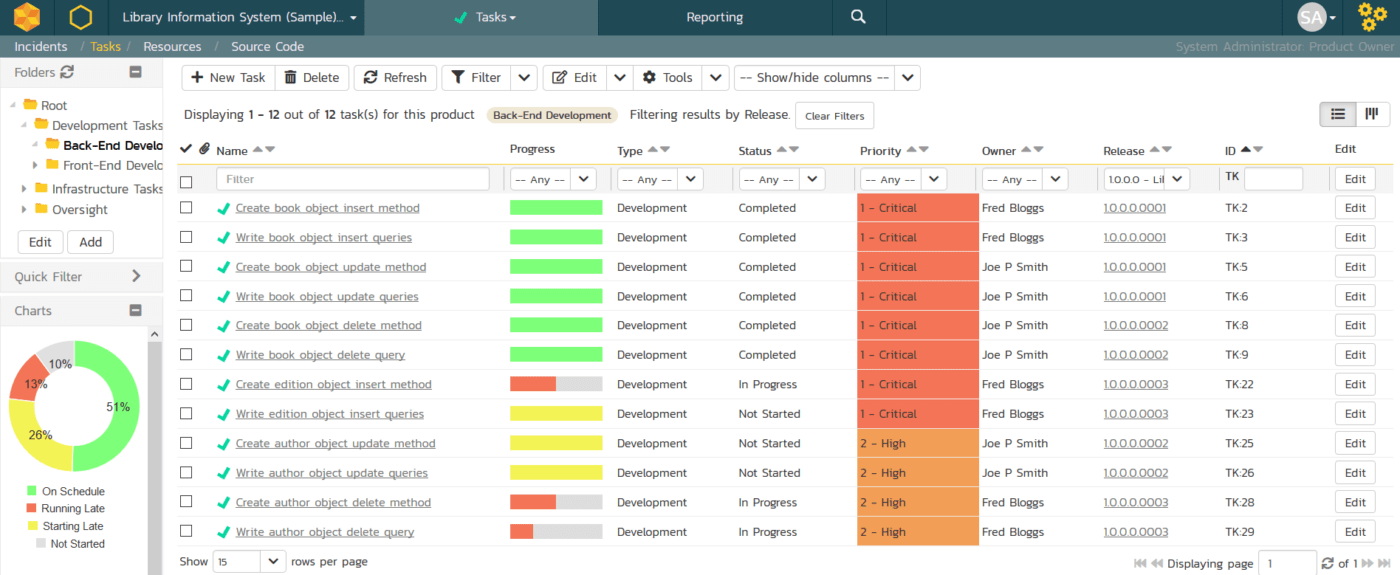
SpiraTeam is a full-fledged application lifecycle management tool. This robust app handles everything from requirements to test cases, codes, and implementation. Your team will work from a central dashboard where they can create user stories, receive task assignments, and track project progress.
SpiraTeam features
- Real-time chat features to make collaboration easier
- Project documents to define, track, and update requirements
- Integrations with leading development and project management platforms
- Personalized ALM dashboard
- Customized workflows to match your projects
SpiraTeam pros
- User-friendly UI
- Versatile to fit multiple types of projects
- Attentive customer support
SpiraTeam cons
- Does not have a sortable backlog
- Pricey on-premise version
SpiraTeam pricing
SpiraTeam offers a cloud version and an on-premise version. The cloud version is priced at $34.69 per concurrent user per month while the on-premise SpiraTeam plan is customized to the number of concurrent users.
Spira Team ratings and reviews
- G2: 4.0/5 (20+ reviews)
- Capterra: 4.1/5 (90+ reviews)
3. Modern Requirements

If you’re already using Azure DevOps, Modern Requirements is a natural choice for requirements management. This tool is built directly into the Azure DevOps platform for seamless and automatic requirements capture.
Modern Requirements features
- Smart requirements docs that update with your user stories
- Use cases that can be turned into requirements with a single click
- Pre-built FAQs to speed up requirements collection
- Traceability matrices to simplify end-to-end requirement traceability
- Collaboration through requirement approval workflows and reviews
Modern Requirements pros
- Advanced regulatory and auditability reports
- Approval workflows come with e-signatures
- Free guided bootcamp
- Handy baseline feature to compare requirements before and after reviews or completion
Modern Requirements cons
- Limited integration with other development tools
- Lacks advanced templates
Modern Requirements pricing
Modern Requirements features a free trial. The pricing is available only on request.
Modern Requirements ratings and reviews
- G2: N/A
- Capterra: N/A
4. Visure

If you’re looking for a requirements management tool that you can configure in a specific way, Visure might be one of your better options. This requirements management tool allows for a lot of customization and flexibility.
But you don’t just get requirements management with Visure—you also get change management, test management, risk management, and issue and defect tracking packed into this thorough software.
Visure features
- Requirements gathering through automatic capture from MS Excel, MS Word, and ReqIF
- Requirement tracking through requirements history
- Versioning at document and element level
- End-to-end traceability of requirements, tests, risks, source code, etc.,
- Requirement verification
- Requirements and test sharing across projects
- Report generation for traceability matrices, custom specifications, and dashboards
Visure pros
- Integrates with top software in the development and engineering industries such as IBM DOORS, JIRA, MATLAB, and VectorCAST
- Supports multiple project methodologies like Agile, V model, and waterfall
- Several industry-specific templates
Visure cons
- Tedious and complicated to create report templates
- Difficult set-up and configuration
Visure pricing
A 30-day free trial and a customized price for the premium version.
Visure ratings and reviews
- G2: 4.5/5 (5+ reviews)
- Capterra: 4.9/5 (10+ reviews)
5. Jama Software
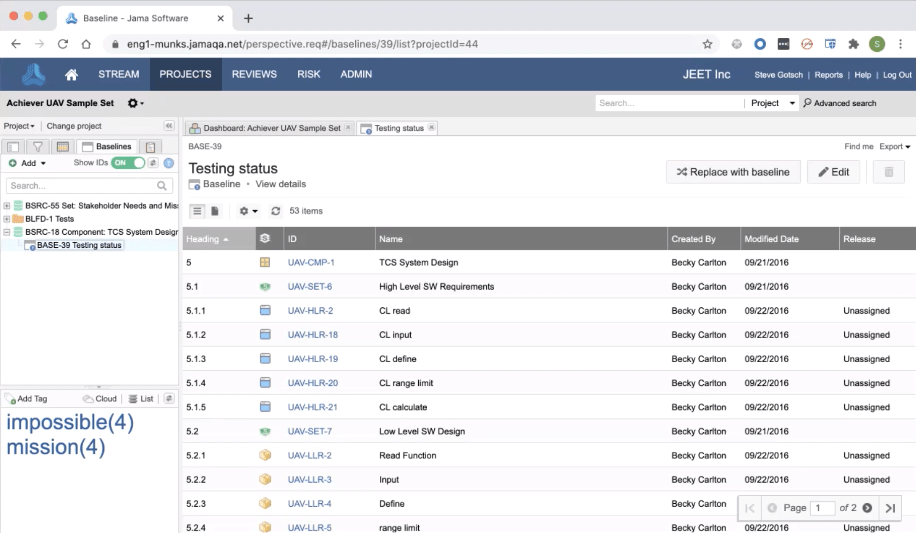
Jama Software is built for complex projects with equally complex requirements.
This requirements management tool offers a space to define requirements, run tests, and foresee risks after requirements analysis.
With Jama, you can capture the project interdependencies, track your progress, and clearly define project goals.
Jama Software features
- Browser-based interface
- Supports multiple engineering disciplines and methodologies
- Live traceability of requirements and processes
- Supports requirements data import and export
- Supports Open Rest API to extend the usability
- Visibility and compliance reporting
- Collaboration in the form of virtual reviews and conversation tracking
Jama Software pros
- Support imports and exports
- Integrates with several development tools such as Jira, Ansys, and Azure DevOps
- Offers both on-premise and cloud-based models to suit your organization’s needs
Jama Software cons
- Lacks templates
- Limited native reporting tools
- Delays and is sluggish at times
- Difficult to set up
Jama Software pricing
Jama Software pricing is only available on request.
Jama Software ratings and reviews
- G2: 4.2/5 (100+ reviews)
- Capterra: 4.5/5 (10+ reviews)
6. Xebrio
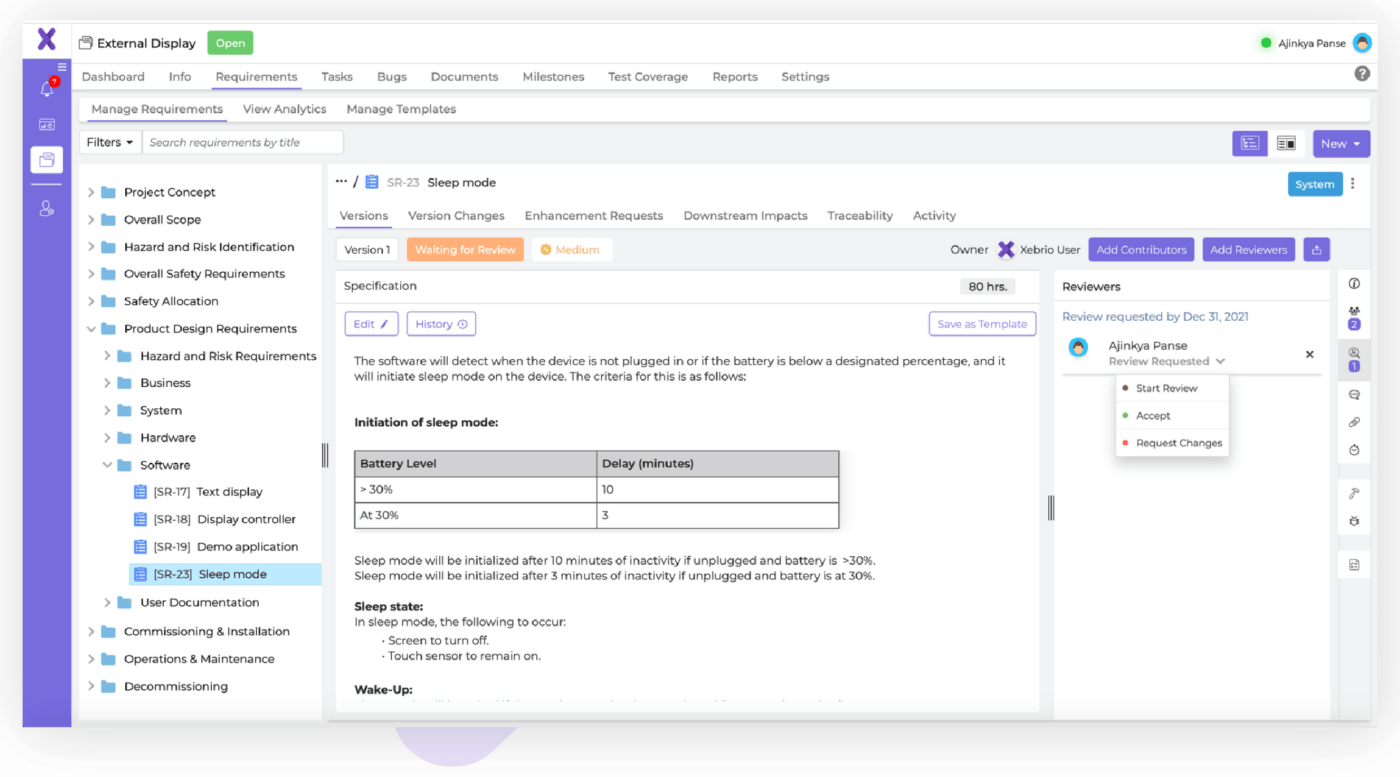
A major feature to look out for in requirements management tools is end-to-end traceability—Xebrio provides this and more. With Xebrio, collaboration during the collection, tracking, and analyzing requirements is a breeze, thanks to intuitive approval workflows. Pair that with bug tracking, and you have a full-fledged project management tool with excellent requirements management capabilities.
Xebrio features
- Project management and requirements management templates
- Requirements approval templates
- Requirements versioning and versioning changes
- Project time tracking
- Document collaboration
Xebrio pros
- Tons of customization options
- Brings multiple features into one—including task management, test coverage, requirements management, and project management
- Unlimited projects on all plans
Xebrio cons
- Fairly newer tool compared to most on this list
- Task management and requirements management are billed separately
Xebrio pricing
The requirements management plan starts at $25 per month, per user. Xebrio also offers a free 14-day trial.
Xebrio ratings and reviews
- G2: N/A
- Capterra: N/A
7. Wrike
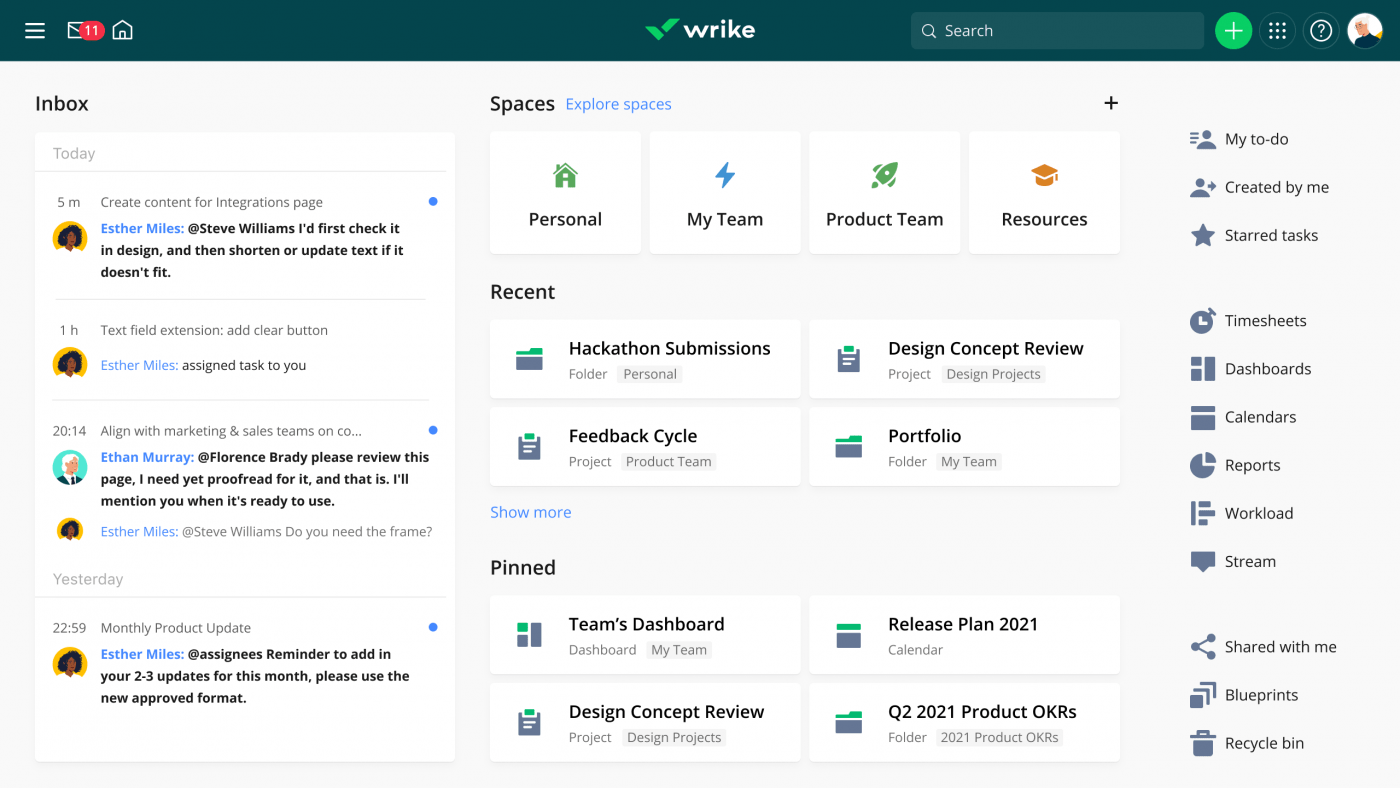
Wrike is a popular work management tool combining workflow automation, project management, and team collaboration into one. But despite its many collaboration features, Wrike is not without drawbacks.
Wrike features
- Real-time updates to any changes and check-off of requirements
- Visual roofing and automated approval forms
- Activity tracking and activity dashboard
- Requirements categorization
Wrike pros
- Tons of templates to simplify workflow creation, define requirements, create reports, and more
- Customizable dashboards, request forms, and workflows
- Interactive Gantt charts and shareable Kanban boards to plan projects and set detailed requirements
- Shared team calendars to stay on top of tasks
Wrike cons
- Steep learning curve as this tool was designed for technical users
- Limited free plan
- Workflows are not as intuitive as you’d expect
- Hard to prioritize requirements with Wrike
Wrike pricing
Wrike’s professional plan starts at $9.80 per user, per month. Wrike also has a free forever plan.
Wrike ratings and reviews
- G2: 4.2/5 (2,500+ reviews)
- Capterra: 4.3/5 (1700+ reviews)
8. IBM DOORS Next

With a good name to back it up, IBM Engineering Requirements Management DOORS Next is a reliable requirements management tool for engineering projects. IBM DOORS Next is a particularly good fit for large enterprises with complex projects needing granularity in every detail. With IBM DOORS Next, you can easily create, track and analyze requirements while conforming to your industry standards and regulations.
Let’s take a look at IBM’s requirements management features.
IBM features
- Watson AI and a Requirements Quality Assistant to provide requirements recommendations
- Create, analyze, and trace requirements in all engineering domains, including SaFe, Agile, lean, and continuous engineering
- Dynamic requirements traceability
- Custom reports and dashboards to view project status
IBM pros
- Available on-premise and in the cloud to offer more flexibility
- Flexible and highly customizable to fit project needs
- Plenty of features for requirements management in a complex project
IBM cons
- Configuration is cumbersome
- Can be pretty pricey for smaller enterprises
- The interface can sometimes feel clucky and outdated.
IBM pricing
Like most other tools, IBM DOORS Next comes with a free trial and price available on request for the premium plan. However, plans start at $164 per month.
IBM ratings and reviews
- G2: 3.9/5 (100+ reviews)
- Capterra: 4.5/5 (2 reviews)
9. Accompa
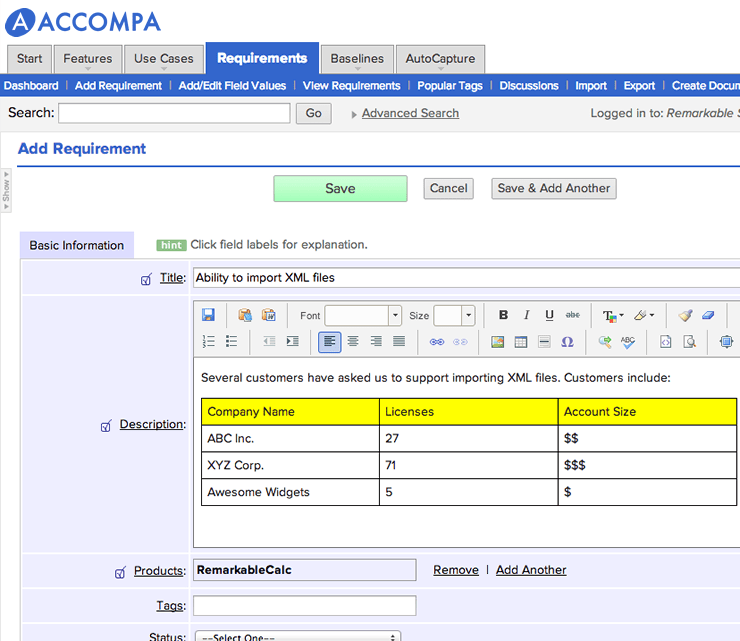
Accompa may not have the most requirements management features out there, but this tool makes up for it with an easy and intuitive UI and one of the best customer support. If you’re a smaller team, you can find all the essential features to make requirements management work seamlessly.
Accompa features
- Automatic tracking of interdependencies and requirements changes
- A central repository for requirement management
- Web browser access to Accompa
- Change history tracking and baseline definitions
- Automatic email alerts and integrated discussion boards
Accompa pros
- Easy to use
- Good customization functionality
- Intuitive search and view features
Accompa cons
- Pricey considering the number of features offered
- Lacks complimentary features like issue tracking and task management
- No templates to help set up your workflow
Accompa pricing
The Standard package starts at $199 and supports 5 users. Any additional user will cost you $29 per month, per user
Accompa ratings and reviews
- G2: 4.0/5 (1 review)
- Capterra: 4.0/5 (1 review)
10. GatherSpace

GatherSpace was founded in 2006 to help agencies and startups optimize requirements management. This requirements management tool comes with project management functionality, a client portal, and requirements management capabilities.
GatherSpace features
- Requirements status tracking
- Prioritization of requirements
- Client portal that seamlessly integrates with the requirements management platform
- A mobile up to track requirements and make requirements updates
GatherSpace pros
- Tailored to smaller teams
- Makes requirement management easier by infusing project management functionality
- Cloud-based, making it easier to access and syncs across devices
GatherSpace cons
- An outdated UI
- Limited customer support materials
- Limited reporting features
- Limited end-to-end traceability
GatherSpace pricing
GatherSpace has a free trial and paid plans starting at $15 per user, per month.
GatherSpace ratings and reviews
- G2: 4.7/5 (2,000+ reviews)
- Capterra: 4.0/5 (3 reviews)
11. Iris Intelligence
Iris Intelligence is an enterprise project risk management software that helps our organization identify and plan risk mitigation for more successful projects. Iris is a scalable platform to the extent that it can work for small construction projects or complex interplanetary missions. 🪐
Iris is best suited for defense, government, finance, aerospace, and construction companies.
Iris features
- Custom reports that you can templatize for reuse
- Portfolio slices to view portfolio data such as requirements by geography and function
- Automated email reminders regarding requirements updates and changes
Iris pros
- Scalable and flexible to fit different projects and teams
- Multiple functionalities, including project management, risk management, and requirements management
- Modern, intuitive, and robust UI
Iris cons
- Limited requirements management features compared to most tools on this list
- Basic collaboration functionality
Iris pricing
Iris pricing is only available on request
Iris ratings and reviews
- G2: N/A
- Capterra: N/A
12. Aqua ALM
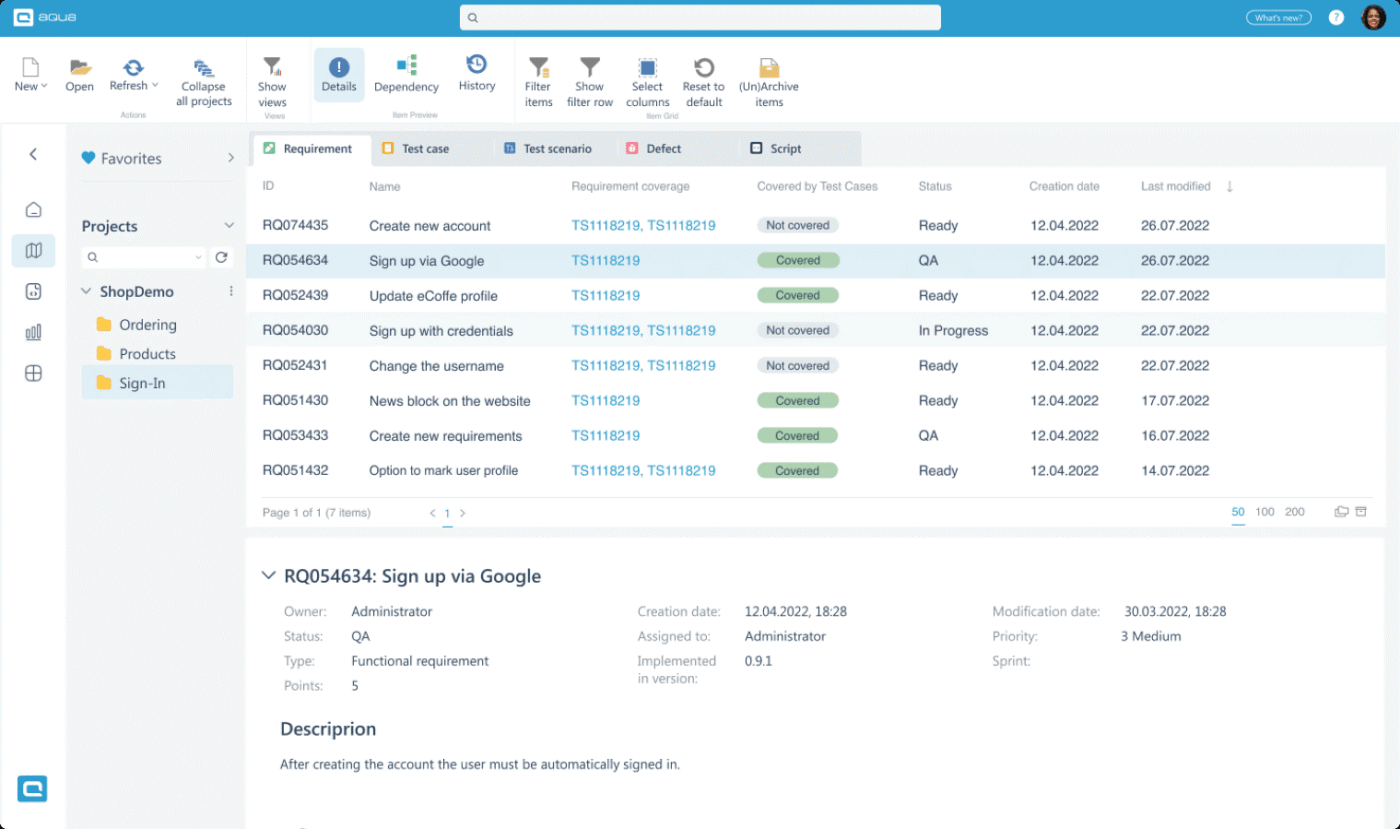
Aqua ALM is primarily a test management platform featuring requirements management. This tool lets you define requirements at the start of the project, update them as the changes happen, and track requirements as the project timeline progresses.
Aqua ALM features
- Customized dependencies
- Workflow limitations and approvals to streamline requirements management
- Notifications about requirements statuses, updates, and more
- Custom fields and workflows
Aqua ALM pros
- You can attach multiple file formats, including PDF, docs, text, and images
- One-click import and export
- Customizable templates
- Improved traceability thanks to its history of changes and reports
- Chrome extension to capture data and record interactions
Aqua ALM cons
- A more traditional layout
- Lacks pre-defined reports
- Aqua ALM can be overwhelming to set up and customize
Aqua ALM pricing
Aqua ALM is pretty pricey, starting around $39 per user, per month. But you can test the waters of this requirements management tool with a 30-day free trial.
Aqua ALM ratings and reviews
- G2: N/A
- Capterra: 4.7/5 (10+ reviews)
13. Jira
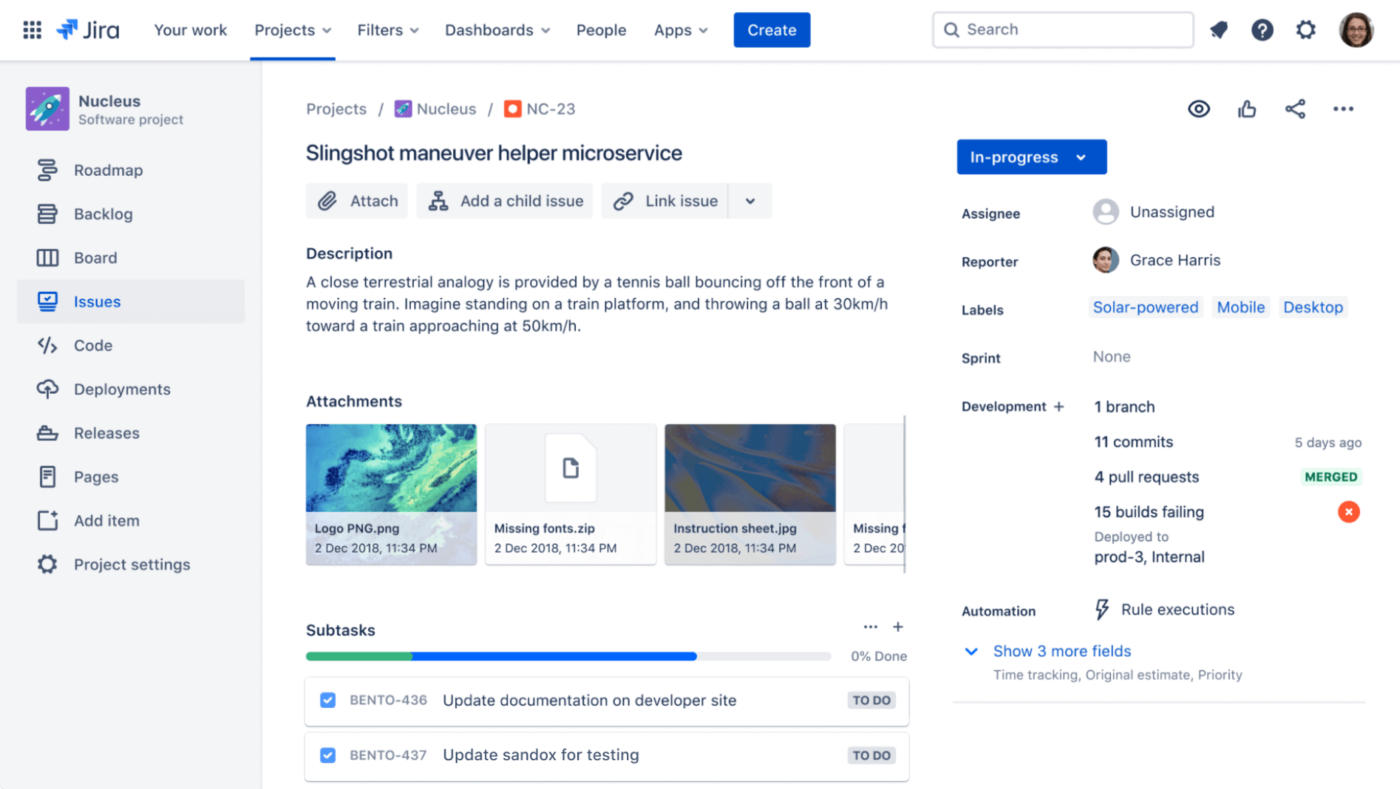
Jira is a powerful and well-known software development product for agile teams. Jira is visual, thanks to Kanban-style boards where you can plan and track tasks, user stories, and issues. The Jira UI is also modern and relatively intuitive. However, Jira can be overwhelming for smaller projects. In that case, you might find a solution in these Jira alternatives.
Jira features
- Ready-made templates for Agile, Scrum, bug tracking, and more
- Scum board for easy requirements management planning, tracking, and analyzing requirements
- Customizable workflows
Jira pros
- More than 3,000 app integrations, including the Jira-Zendesk integration
- Superb cloning and requirements prioritization functionality
- Allows multiple attachments such as images, videos, logs, and links
Jira cons
- Difficult to configure and learn
- Takes a significant amount of bandwidth and requires over-the-top network availability
- The search filters are not user friendly
Jira pricing
Jira comes with a free plan for up to 10 users. If you want more features and user support, the premium plans start at $7.50 per user, per month.
Jira ratings and reviews
- G2: 4.2/5 (4,000+ reviews)
- Capterra: 4.4/5 (12,000+ reviews)
14. Valispace
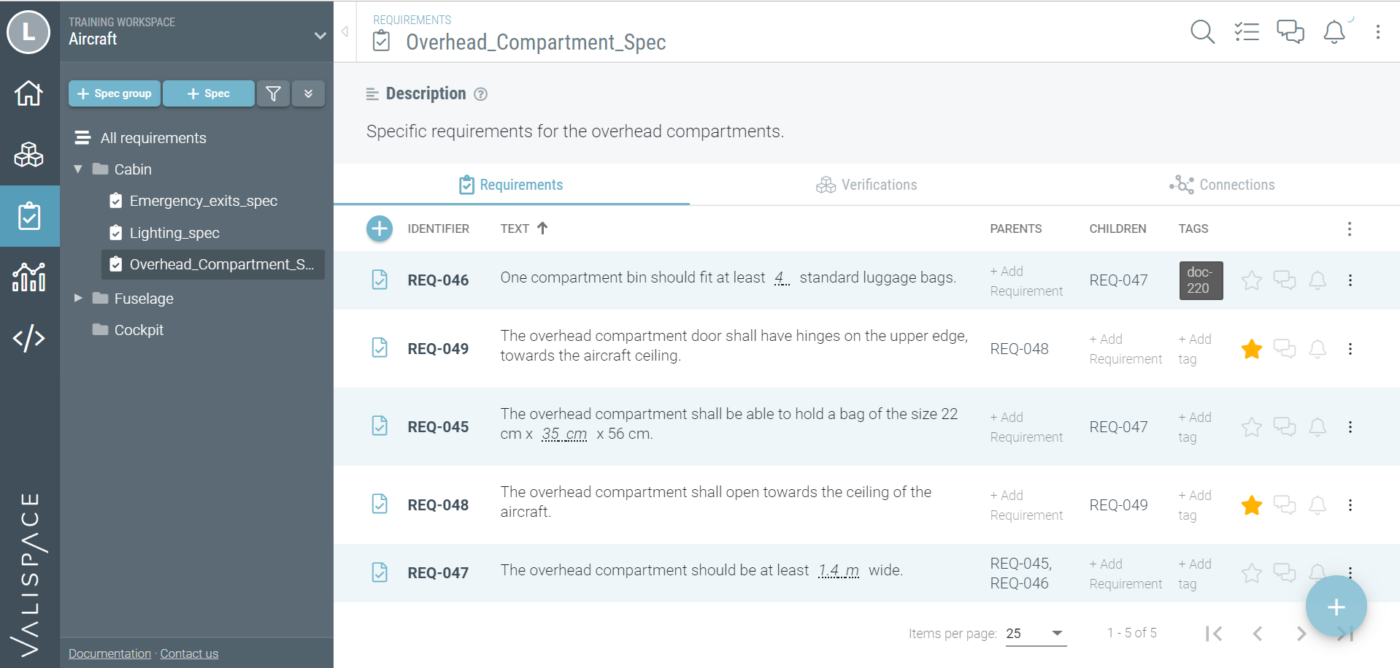
This browser-based software is an engineering team’s best friend when it comes to requirements management. Valispace is mostly dedicated to teams that develop hardware products such as satellites, airplanes, and rockets.
With Valispace, engineering teams can handle these complex projects from the requirements definition all through until testing is complete. Here are more features to know about:
Valispace features
- Real-time collaboration with teams, suppliers, and clients
- Full requirement traceability
- Detailed design and simulations
- Requirements change history tracking
- Custom requirement verification methods
Valispace pros
- Detailed user permission and automated approval workflows
- Templates to ease the setup process for new project requirements
- Commenting and chat features for team communication in the app
Valispace cons
- Some features may lag or not work as quickly as needed
- Limited information in project reports
Valispace pricing
Valispace paid plans start around $250.
Vailspace ratings and reviews
- G2: N/A
- Capterra: 5.0/5 (1+ reviews)
15. Aha
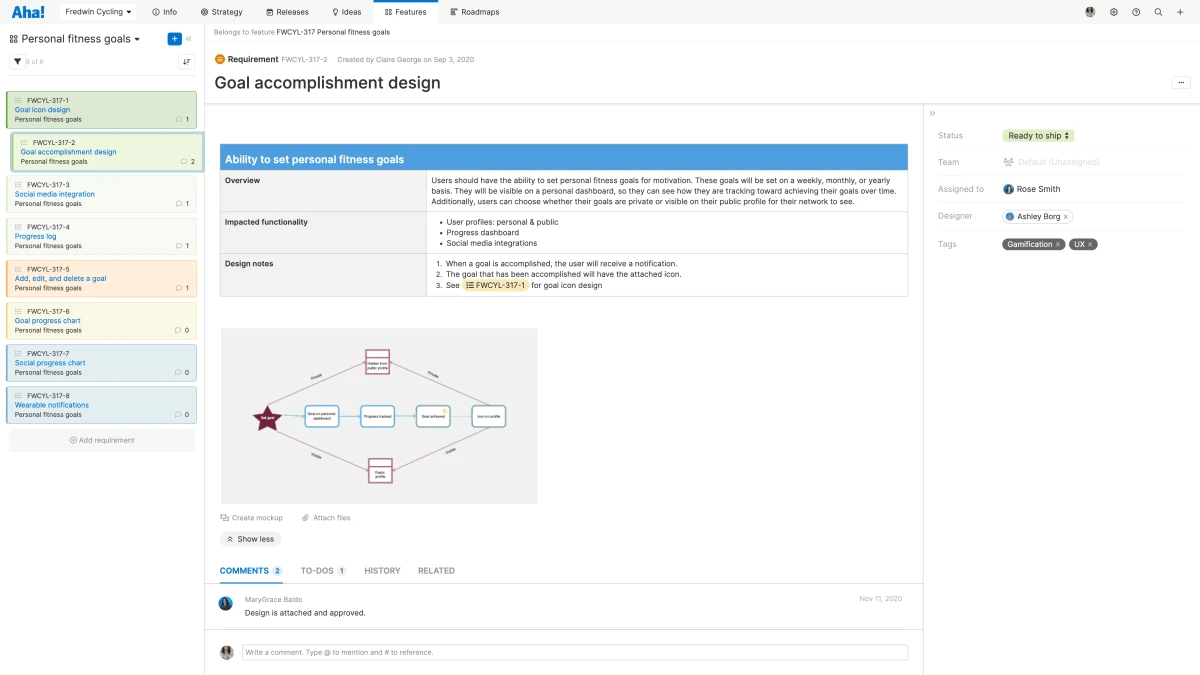
Aha is primarily a product development software with specialized requirements management functionality. This tool lets you prioritize product features through sprint planning boards and scorecards. When defining requirements with Aha, you can insert checklists, and tables, link requirements to other existing documents, and create mockups.
Aha features
- A planning board to manage requirements and plan upcoming releases
- Kanban boards to view the status of your requirements
- Requirements approval gates to guarantee certainty as you progress with the project
- Story maps to get a good visual of the client’s needs
Aha pros
- Integrates with more than 30 apps cutting across project management, CRM, and analytics
- Comprehensive features to suit any team’s needs
- Easy customization to fit your team and company
Aha cons
- While comprehensivity is an advantage, too many features and reports make this tool overwhelming
- Limited training materials to take full advantage of Aha features
- A bit expensive
- Steep learning curve
Aha pricing
Aha paid packages start at $59 per user, per month. There’s also a free 30-day trial to help you determine if Aha would be a good fit for you.
Aha ratings and reviews
- G2: 4.3/5 (200+ reviews)
- Capterra: 4.7/5 (400+ reviews)
Simplify Requirements Management With ClickUp
Without proper planning and a powerful requirements management tool, managing project requirements is hectic—to say the least.
Plus, you’ll run the risk of disappointing your clients or delivering a product that you’re simply not proud of. 🙁
These requirements management tools can help you plan, define, and track requirements for more successful projects. And since your new software can lighten the load when it comes to requirements management, you can spend more time on the tasks that really matter—working with your team, creating high-quality products, and making new connections through happy clients.
Invest in a tool that strikes a balance between your top, must-have requirements management features and an affordable price—like ClickUp. 🥰
You don’t just get a tool to manage requirements—you get the ultimate productivity platform to centralize your work and streamline your processes with advanced workflow automation, project management, and collaboration fit for modern teams of any size, across industries.
Sign up for ClickUp for free to start simplifying and automating requirements management ASAP. 💯




